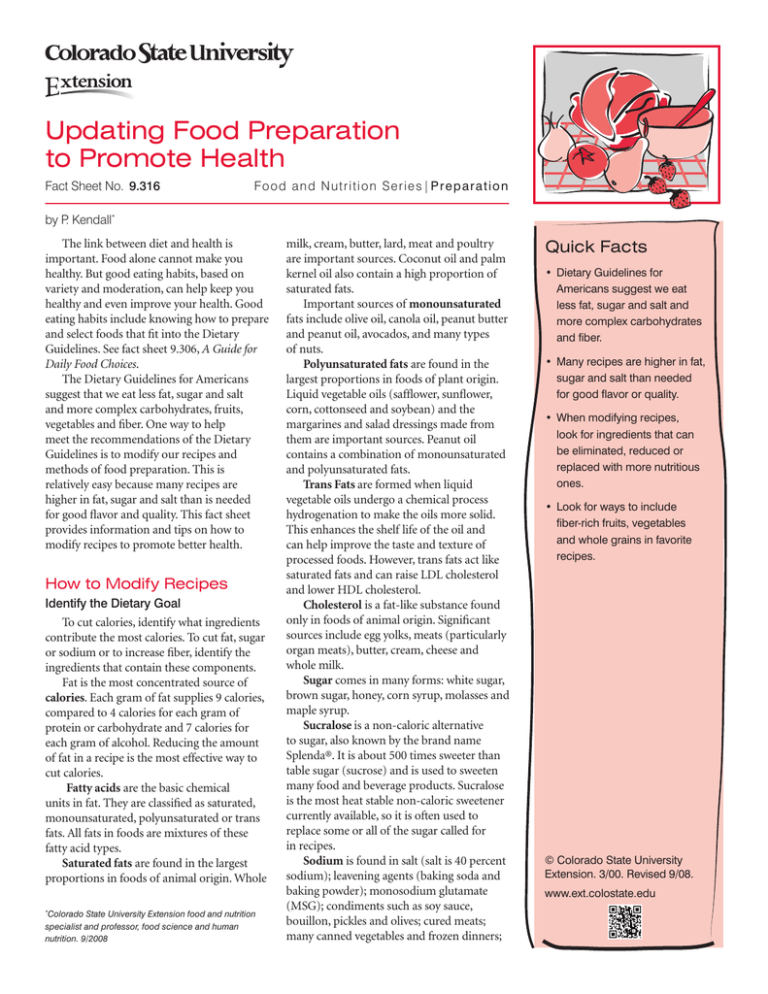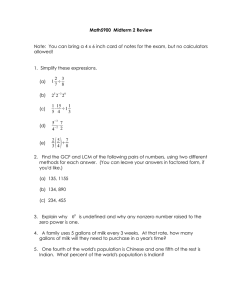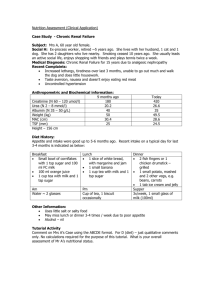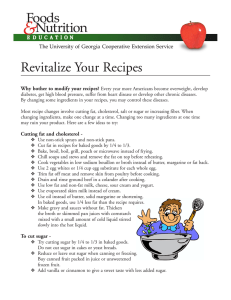Quick Facts
advertisement

Updating Food Preparation to Promote Health Fact Sheet No.9.316 Food and Nutrition Series| Preparation by P. Kendall* The link between diet and health is important. Food alone cannot make you healthy. But good eating habits, based on variety and moderation, can help keep you healthy and even improve your health. Good eating habits include knowing how to prepare and select foods that fit into the Dietary Guidelines. See fact sheet 9.306, A Guide for Daily Food Choices. The Dietary Guidelines for Americans suggest that we eat less fat, sugar and salt and more complex carbohydrates, fruits, vegetables and fiber. One way to help meet the recommendations of the Dietary Guidelines is to modify our recipes and methods of food preparation. This is relatively easy because many recipes are higher in fat, sugar and salt than is needed for good flavor and quality. This fact sheet provides information and tips on how to modify recipes to promote better health. How to Modify Recipes Identify the Dietary Goal To cut calories, identify what ingredients contribute the most calories. To cut fat, sugar or sodium or to increase fiber, identify the ingredients that contain these components. Fat is the most concentrated source of calories. Each gram of fat supplies 9 calories, compared to 4 calories for each gram of protein or carbohydrate and 7 calories for each gram of alcohol. Reducing the amount of fat in a recipe is the most effective way to cut calories. Fatty acids are the basic chemical units in fat. They are classified as saturated, monounsaturated, polyunsat­urated or trans fats. All fats in foods are mixtures of these fatty acid types. Saturated fats are found in the largest proportions in foods of animal origin. Whole Colorado State University Extension food and nutrition specialist and professor, food science and human nutrition. 9/2008 * milk, cream, butter, lard, meat and poultry are important sources. Coconut oil and palm kernel oil also contain a high proportion of saturated fats. Important sources of monounsaturated fats include olive oil, canola oil, peanut butter and peanut oil, avocados, and many types of nuts. Polyunsaturated fats are found in the largest proportions in foods of plant origin. Liquid vegetable oils (safflower, sunflower, corn, cottonseed and soybean) and the margarines and salad dressings made from them are important sources. Peanut oil contains a combination of monounsaturated and polyunsaturated fats. Trans Fats are formed when liquid vegetable oils undergo a chemical process hydrogenation to make the oils more solid. This enhances the shelf life of the oil and can help improve the taste and texture of processed foods. However, trans fats act like saturated fats and can raise LDL cholesterol and lower HDL cholesterol. Cholesterol is a fat-like substance found only in foods of animal origin. Significant sources include egg yolks, meats (particularly organ meats), butter, cream, cheese and whole milk. Sugar comes in many forms: white sugar, brown sugar, honey, corn syrup, molasses and maple syrup. Sucralose is a non-caloric alternative to sugar, also known by the brand name Splenda®. It is about 500 times sweeter than table sugar (sucrose) and is used to sweeten many food and beverage products. Sucralose is the most heat stable non-caloric sweetener currently available, so it is often used to replace some or all of the sugar called for in recipes. Sodium is found in salt (salt is 40 percent sodium); leavening agents (baking soda and baking powder); monosodium glutamate (MSG); condiments such as soy sauce, bouillon, pickles and olives; cured meats; many canned vegetables and frozen dinners; Quick Facts • Dietary Guidelines for Americans suggest we eat less fat, sugar and salt and more complex carbo­hydrates and fiber. • Many recipes are higher in fat, sugar and salt than needed for good flavor or quality. • When modifying recipes, look for ingredients that can be eliminated, reduced or replaced with more nutritious ones. • Look for ways to include fiber-rich fruits, vegetables and whole grains in favorite recipes. © Colorado State University Extension. 3/00. Revised 9/08. www.ext.colostate.edu and most cheeses, sauces, soups and salad dressings. Fiber is found in whole grain breads and cereals, dry beans and peas, nuts and seeds, and fruits and vegetables­– especially those with edible skins or seeds. Change the Ingredients to Achieve the Dietary Goal Ingredients can be eliminated completely, reduced in amount, or replaced with a more nutritionally acceptable ingredient. To choose the best approach, it’s helpful to have a general idea of the function of the ingredient and what will happen if it is changed. Table 1 lists the functions of several ingredients. Table 1. Function of various ingredients. Fat • Provides flavor and richness. • Improves texture and tenderness in baked goods. • Promotes flakiness and lightness. • Promotes smoothness and creaminess. Eggs • Provide structure, elasticity and richness. • Act as a thickener and emulsifier. • Act as leavening agents when beaten. Sugar • Provides flavor, volume and texture. • Increases tenderness and browning in baked goods. • Acts as a preservative in jams, jellies and pickles. • Acts as food for yeast. Sodium • Provides flavor. • Acts as a preservative in cured meats and in brined vegetables. • Controls action of yeast. Tips for Healthy Modifications Here are a few ways to update recipes. These sugges­tions apply to most foods except when specific proportions of ingredients are essential to prevent spoilage (such as cured meats, pickles, jams and jellies). Decrease Total Fat and Calories • Reduce fat by one-fourth to one-third in baked products. For example, if a recipe calls for 1 cup hydrogenated shortening, try 2/3 cup oil. This works best in quick breads, muffins and cookies. • In recipes such as muffins and snack cakes, try replacing half to all of the fat with prune puree, lowfat yogurt or Table 2. Handy facts.* Calories Values for 1 Tbsp: Vegetable oil (corn) 125 Vegetable shortening 115 Butter 100 Margarine 100 Reduced-calorie margarine 50 Mayonnaise 100 Reduced-calorie mayonnaise 35 White sugar 45 Honey 65 Values for 1 cup: Whole milk 150 Low-fat (2%) milk 120 Fat-free milk 90 Half-and-half 315 Evaporated skim milk 200 Cream, heavy whipping 820 Sour cream 495 Plain low-fat yogurt 145 Plain nonfat yogurt 125 Values for:Values for: 1 whole egg 75 2 egg whites 30 TotalSaturated Fat FatCholesterol g g mg 14 1.8 13 3.3 11 7.1 11 2.2 5 1.1 11 1.7 3 0.5 0 0.0 0 0.0 0 0 31 0 0 8 4 0 0 8 5 tr 28 1 88 48 4 0 5.1 2.9 0.3 17.3 0.3 54.8 30.0 2.3 0.3 33 18 4 89 9 326 102 14 4 5 0 1.6 0.0 213 0 *Values are approximate. Check product labels for nutritional values of specific brands. tr = trace. • • • • • • • unsweetened applesauce. The pectin in these “fat replacers” helps hold the product together and gives the mouthfeel of fat. Because they add sugar calories, you also may want to decrease the added sugar by one-fourth. Cut back or even eliminate added fat in casseroles and main dishes. For example, browning meat in added fat is unnecessary because some fat will drain from the meat as it cooks. Use a microwave oven, nonstick pan or cooking spray. Saute or stir-fry vegetables with little fat or use water, wine or broth. To thicken sauces and gravies without lumping, eli­minate fat and mix cornstarch or flour with a small amount of cold liquid. Stir this mixture slowly into the hot liquid to be thickened and bring it to a boil, stirring constantly. Add herbs, spices and flavorings. Chill soups, gravies and stews; skim off hardened fat before reheating to serve. Select lean cuts of meat and trim off visible fat. Remove skin from poultry before cooking. Bake, broil, grill, poach or microwave meat, poultry or fish instead of frying. Decrease the proportion of oil in homemade salad dressings. Try onethird oil to two-thirds vinegar. Low-fat cottage cheese or buttermilk seasoned with herbs and spices also makes a lowfat dressing. • Use reduced-calorie sour cream or mayonnaise. To reduce fat further, use plain low-fat or nonfat yogurt, buttermilk or blended cottage cheese instead of regular sour cream or mayonnaise for sauces, dips and salad dressings. If you heat a sauce made with yogurt, add 1 tablespoon of cornstarch to 1 cup of yogurt to prevent separation. • Use fat-free or low-fat milk instead of whole milk. For extra richness, try fatfree milk. • Choose low-fat cheeses such as feta, neufchatel and mozzarella instead of high-fat ones such as Swiss or cheddar. Also use less cheese. Decrease Saturated Fat and Cholesterol • Use two egg whites or an egg substitute product instead of one whole egg. In some recipes, simply decrease the total number of eggs. This is especially true if the fat and sugar also are decreased in the recipe. • Use margarine instead of butter. Look for margarines that contain no trans fats and list liquid vegetable oil as the first ingredient. • Use vegetable oils instead of solid fats. To substitute liquid oil for solid fats, use about one-fourth less than the recipe calls for. For example, if a recipe calls for 1/4 cup (4 tablespoons) of solid fat, Table 3. Basic recipe proportions. Liquid 1 Baking Other Product Flour (milk or other) Fat 2Eggs 2Sugar 2Salt 3powder 4ingredients Biscuits 1 c 1/3 - 1/2 c 2 - 4 Tbsp — — 1/4 - 1/2 tsp 3/4 - 1 1/4 tsp — Cake with fat 1 c 1/4 - 1/2 c 2 - 6 Tbsp 1/2 - 1 1/2 - 1 c 1/8 - 1/2 tsp 3/4 - 1 1/4 tsp flavoring Cake, chiffon 1 c 1/3 - 1/2 c 2 - 4 Tbsp 1 - 3 1/2 - 3/4 c 1/4 - 1/2 tsp 3/4 - 1 1/4 tsp 1/4 tsp (cake) (oil) cream of tartar Griddle cakes 1 c 3/4 - 7/8 c 1 - 4 Tbsp 1/2 - 1 0 - 4 Tbsp 1/4 - 1 tsp 3/4 - 1 1/4 tsp — Muffins 1 c 1/3 - 1/2 c 2 - 4 Tbsp 1/2 - 1 1 - 6 Tbsp 1/4 - 1/2 tsp 3/4 - 1 1/4 tsp — Quick bread 1 c 2 - 3 Tbsp 2 - 5 Tbsp 1/2 - 1 1/2 2 - 8 Tbsp 1/4 - 1/2 tsp 3/4 - 1 1/4 tsp — Yeast bread 1 c 1/3 c 0 - 2 Tbsp 0 - 1 1/2 - 1 Tbsp 1/4 - 1/2 tsp — 1/2 - 3/4 tsp dry yeast 1 For leaner formula and at higher altitudes, choose larger amount. 2 For leaner formula and at higher altitudes, choose smaller amount. (May need to use larger number of eggs at high attitude.) 3 Choose smaller amount to lower sodium in recipe. 4 Use larger amount at 3,000 to 4,000 feet; mid-range at 4,000 to 6,000 feet; smaller amount above 6,000 feet. Note: 3 tsp = 1 Tbsp; 4 Tbsp = 1/4 cup; 16 Tbsp = 1 cup. use 3 tablespoons of oil. For cakes or pie crusts, use a recipe that specifically calls for oil, because liquid fats require special mixing procedures. Decrease Sugar • Reduce sugar by one-quarter to onethird in baked goods and desserts. Add extra spice or flavoring to enhance impression of sweetness. This works best with quick breads, cookies, pie fillings, custard, puddings and fruit crisps. • Decrease or eliminate sugar when canning or freezing fruits. Buy unsweetened frozen fruit or fruit canned in its own juice or water. • In cookies, bars and cakes, replace onequarter of the sugar called for with an equal amount of nonfat dry milk. This reduces calories and increases calcium, protein and riboflavin in the recipe. • Choose fruit juices, club soda or skim milk over soft drinks and punches. Make fruit juice coolers with equal parts fruit juice and club soda or seltzer. • Nonsugar sweeteners can replace part or all of the sugar in many recipes. However, most have limitations. Aspartame (Equal®) will not work well in products that are cooked or baked. Saccharin can be used in hot and cold foods but may leave a bitter aftertaste. Sucralose is heat stable, but works better in recipes like pies and quick breads where sugar is primarily used to provide sweetness rather than texture, volume and browning. In such cases, using a sucralose blend made from half sugar and half sucralose may work. Be aware, however, that none of the non-caloric sugar substitutes provide the volume or structure that sugar does, so rather than simply substitute, it’s best to choose recipes especially tested for use with nonsugar sweeteners. Decrease Sodium • Salt may be omitted or reduced in most recipes. Do not reduce salt in cured meats or pickled or brined vegetables it acts as a preservative. A small amount is useful in yeast breads to help control the rising action of the yeast. • Start with a gradual reduction. For example, if a recipe calls for 1 teaspoon of salt, try 1/2 teaspoon. If you reduce the amount of salt gradually, you’ll soon adjust to a less salty flavor. Choose fresh or low-sodium versions of soups and broths, soy sauce, canned vegetables and tomato products. • Rely on herbs and spices for flavor, rather than salt. • Use garlic or onion powder instead of garlic or onion salt. • Omit salt from water when cooking pasta, noodles, rice or hot cereals. • Try fruit juice or wine for cooking liquid instead of broth or bouillon. • Read labels. Any ingredient that includes sodium in its name contains sodium. Increase Fiber • Choose whole grain instead of highly refined products (whole-wheat flour and bread, bulgur, brown rice, oatmeal, whole cornmeal and barley). • Whole-wheat flour usually can be substituted for part or all of the allpurpose flour. If a recipe calls for 2 cups of all-purpose flour, try 1 cup of all-purpose and 1 cup of whole-wheat flour. When completely substituting whole-wheat for white flour, use 7/8 cup whole-wheat flour for 1 cup of white flour. • Add extra fruits and vegetables to recipes. • Add fruits to muffins, pancakes, salads and desserts, and add vegetables to quiche fillings, casseroles and salads. When To Modify Recipes Not all recipes need modification. Is the recipe already low in fat, cholesterol, sugar or salt? If so, only minor or no changes may be needed. If a recipe calls for one egg and the dish serves eight people, the amount of cholesterol per serving already is relatively low. How often is the food eaten? It is not as important to modify a recipe for a dish eaten once or twice a year as it is for foods eaten more often. It is more important to cut the fat in a weekly tuna fish salad sandwich than it is to cut the fat in a birthday cake. How much of the food is eaten? Sometimes the best way to modify the intake of a certain food is to eat less of it. Decreasing the quantity eaten may be more satisfying than decreasing the quality. Many people prefer to eat less real jam or jelly than to eat the regular amount of a low-sugar jam. Putting It Into Practice To begin, look at the ingredients in the recipe and review their functions. Then look at the general guidelines for modifying ingredients. To modify a baked product, compare the recipe with the basic recipe proportions given in Table 3. To do this, express ingredients in terms of 1 cup of flour. If the recipe calls for 2 cups of flour and 1/2 cup sugar, it calls for 1/4 cup sugar for every 1 cup flour. Decide what ingredients to reduce. Compare the amounts of fat, eggs, sugar and salt per 1 cup flour with the amounts given in Table 3. Those on the high end of the range are the ones to reduce. Reduce fat or sugar to at least the midpoint of the range. Reduce eggs, if needed, to within the range. Reduce sodium if desired. Decide which ingredients to increase. Fat and sugar provide moistness and richness to recipes. When they are reduced, add liquid back, usually in the form of water, milk, fruit juice, applesauce, or fruit or vegetable pulp. (Fruit and vegetable pulp also add fiber; milk adds calcium.) Add back at least half as much liquid as sugar and fat reduced. For example, if you reduce the sugar in a recipe by 2 tablespoons and fat by 4 tablespoons, add 3 tablespoons milk or fruit juice. Note that honey and molasses have greater moisture retaining properties than sugar. Replacing a portion of the sugar that remains in the recipe with honey or molasses also may improve the softness and moistness of the resulting product. Consider adding nonfat dry milk to increase the calcium content of the product. In many baked recipes, nonfat dry milk can replace up to one-fourth of the sugar in a recipe with good results. Also, 2 to 4 tablespoons of nonfat dry milk powder per cup of flour may be added to cookies and cakes as an additive. Add as much nonfat dry milk powder to the recipe as sugar reduced. Try the recipe. Do not overbake. Products with less sugar are not as brown as those with more sugar. Evaluate the quality and flavor. If the recipe still seems richer than necessary, reduce fat and sugar further and further increase liquid. If the product seems dry, consider adding more liquid (water, fruit juice, applesauce, fruit or vegetable pulp). Or substitute honey or molasses for a portion of the sugar. References Stark, C. Revitalize Your Recipes for Better Health, Cornell Cooperative Extension, April 1988. Nutritive Values of Foods, U.S. Department of Agriculture, Home and Garden Bulletin 72, 1991. Colorado State University, U.S. Department of Agriculture and Colorado counties cooperating. CSU Extension programs are available to all without discrimination. No endorsement of products mentioned is intended nor is criticism implied of products not mentioned.




